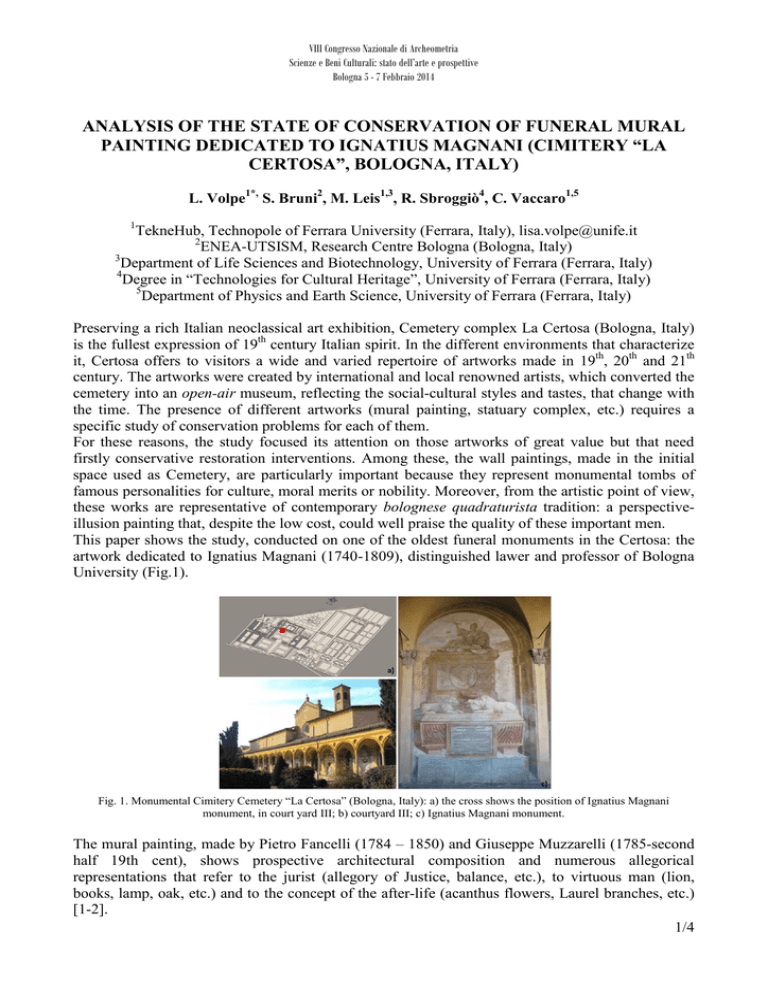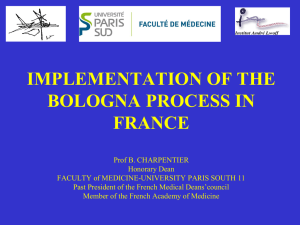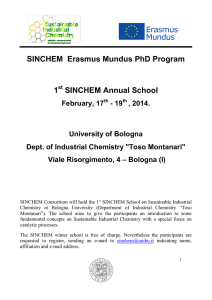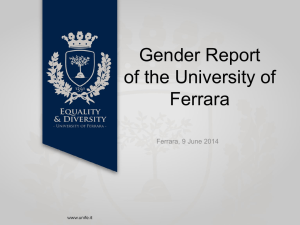Volpe et al, ANALYSIS OF THE STATE OF CONSERVATION OF
advertisement

VIII Congresso Nazionale di Archeometria Scienze e Beni Culturali: stato dell’arte e prospettive Bologna 5 - 7 Febbraio 2014 ANALYSIS OF THE STATE OF CONSERVATION OF FUNERAL MURAL PAINTING DEDICATED TO IGNATIUS MAGNANI (CIMITERY “LA CERTOSA”, BOLOGNA, ITALY) L. Volpe1*, S. Bruni2, M. Leis1,3, R. Sbroggiò4, C. Vaccaro1,5 1 TekneHub, Technopole of Ferrara University (Ferrara, Italy), lisa.volpe@unife.it 2 ENEA-UTSISM, Research Centre Bologna (Bologna, Italy) 3 Department of Life Sciences and Biotechnology, University of Ferrara (Ferrara, Italy) 4 Degree in “Technologies for Cultural Heritage”, University of Ferrara (Ferrara, Italy) 5 Department of Physics and Earth Science, University of Ferrara (Ferrara, Italy) Preserving a rich Italian neoclassical art exhibition, Cemetery complex La Certosa (Bologna, Italy) is the fullest expression of 19th century Italian spirit. In the different environments that characterize it, Certosa offers to visitors a wide and varied repertoire of artworks made in 19th, 20th and 21th century. The artworks were created by international and local renowned artists, which converted the cemetery into an open-air museum, reflecting the social-cultural styles and tastes, that change with the time. The presence of different artworks (mural painting, statuary complex, etc.) requires a specific study of conservation problems for each of them. For these reasons, the study focused its attention on those artworks of great value but that need firstly conservative restoration interventions. Among these, the wall paintings, made in the initial space used as Cemetery, are particularly important because they represent monumental tombs of famous personalities for culture, moral merits or nobility. Moreover, from the artistic point of view, these works are representative of contemporary bolognese quadraturista tradition: a perspectiveillusion painting that, despite the low cost, could well praise the quality of these important men. This paper shows the study, conducted on one of the oldest funeral monuments in the Certosa: the artwork dedicated to Ignatius Magnani (1740-1809), distinguished lawer and professor of Bologna University (Fig.1). Fig. 1. Monumental Cimitery Cemetery “La Certosa” (Bologna, Italy): a) the cross shows the position of Ignatius Magnani monument, in court yard III; b) courtyard III; c) Ignatius Magnani monument. The mural painting, made by Pietro Fancelli (1784 – 1850) and Giuseppe Muzzarelli (1785-second half 19th cent), shows prospective architectural composition and numerous allegorical representations that refer to the jurist (allegory of Justice, balance, etc.), to virtuous man (lion, books, lamp, oak, etc.) and to the concept of the after-life (acanthus flowers, Laurel branches, etc.) [1-2]. 1/4 VIII Congresso Nazionale di Archeometria Scienze e Beni Culturali: stato dell’arte e prospettive Bologna 5 - 7 Febbraio 2014 Above the sarcophagus with tombstone and engraved inscriptions of Magnani, there is a circular medallion, in which profile of Ignatius Magnani is painted and decorated by laurel branches and oak. The preliminary investigations in situ allowed to observe problems related to physical chemical and biological degradation phenomena, probably due both to used artistic technique (mural painting and not fresco) and to environmental external agents (atmospheric agents, pollutants, phenomena of capillary rise, etc.). Fig. 2. Degradation phenomena on the funerary monument: a) surface with black spots; b) film-white paint; c) tombstone; d) deficiencies, lifting the film. Moreover, past restoration works, carried out in 19th and 20th century, caused further deterioration phenomena (white and glossy films, pictorial losses, etc.), probably linked to the inadequacy of the used products. The presence of black µspots, located on different portions of the pictorial film (Fig. 2a), suggests a biological attack under the covering dust deposits. Black crusts, yellowing and loss of material were found, finally, both on tombstone dedicated to Ignatius Magnani (Fig. 2 c) and on the gravestones of his heirs, where loss of pigments in the inscriptions and discoloration could be caused by old waxes applied on the surface (Fig. 2 c). Considering this aspects, an analytical survey, carried out on samples of microscopic size (Fig.3), taken from the artifact, can allow the correct interpretation of the opera and of the environment in which it is inserted. Research on samples were aimed at the identification of artistic technique, materials (pigments film pictorial, intonachino, protective, etc.) and the evaluation of chemicalphysical and biological degradation. Optical (OM) and electronic microscopy (SEM) with chemical microanalysis (SEM–EDS), providing useful support for the design of future conservative restoration and maintenance works. Fig. 3. Sampling points’ map. 2/4 VIII Congresso Nazionale di Archeometria Scienze e Beni Culturali: stato dell’arte e prospettive Bologna 5 - 7 Febbraio 2014 Results of investigations confirms the hypothesis about artistic techniques (mural painting with organic medium and not fresco) and transposition of the sketch on the decorative surface. To obtain different colors, the artists used common pigments (ochres, etc.) (Fig. 4); meanwhile, during the subsequent restoration, titanium dioxide was used, probably as an additional protective. The application of a protective film made by synthetic type resins (i.e. polyvinyl resin) could cause lifters and posting of pictorial material (Fig. 2b, 2d). Fig.4. Pictorial film: a) brune-red area;b) black pigment in inscription; c) SEM image, d) OM image, e) SEM/EDS of sample n. 3 (red ochre). Furthermore, morphological study, carried out at SEM, confirms the presence of biotic attack (Fig. 5), showing, in fact, an abundant growth of fungal mycelium on the film surface and in material’s porosity (Fig. 5c, 5e). The growth of fungal species also interested the ink of the letter I and the marble tombstone: the loss of material and pigment cohesion is due, then, to biodegradation. Fig. 5. Fungal colony on pictorial surface: a) b) macro-photography, c) e) SEM image, d) OM image. Even if SEM investigation allowed to study the morphology of organisms involved in the degradation of artistic artifact (Fig. 5), suggesting the presence of Baudoinia compniacensis (Richon) and fungi Aureobasidium, it would be appropriate to proceed by culture and subsequent analysis of molecular biology for a sure identification in order to find more focused and effective action of cleaning and maintenance [3]. 3/4 VIII Congresso Nazionale di Archeometria Scienze e Beni Culturali: stato dell’arte e prospettive Bologna 5 - 7 Febbraio 2014 Therefore, to determine the nature of the organic material, it would be useful to deep the search through more in-depth investigation (GC-MS, etc.) in order to identify the most compatible products for cleanup operations, not damaging pictorial film. Finally, considering the delicacy of the this monument, its terms and conditions, it will be opportune a future reversible restoration, which objectives are both the re-establishment of cohesion-adhesion of the pictorial film and the full refund painted image readability. Reference [1] Quintavalle, A. C., 2004. I colori del silenzio. Comune di Bologna, Bologna. [2] Rocchetta, C., Zaniboni, C., 2001. La Certosa di Bologna. Editrice Compositori, Bologna. [3] Scott, J. A, Untereiner, W. A. Ewaze, J. O., Wong B. Doyle, D., 2007. Baudoinia, a new genus to accommodate Torula compniacensis. Mycologia, 99 (4): 592-601. 4/4






